A Good Start . . . Learning to See
I often think that the many things we are drawn to as children may well indicate what we will embrace in our unfolding future. Several things jump out at me that became integral and cohesive elements of adult life for me, woodworking, artwork of several types but especially pencil drawing, nature and the study of wildlife local to my at-the-moment habitat and writing. Unquestionably, these four stalwarts have remained firmly in my daily life. In the great cities of my youth, starlings held my gaze in their murmurings, swift-circling flocks that never collide and the poop-dodging public moving from the pavements to the road for safety to the isolated grubbing of the lone Dunnock under the hedges. Several other interests colour my life with less impact.
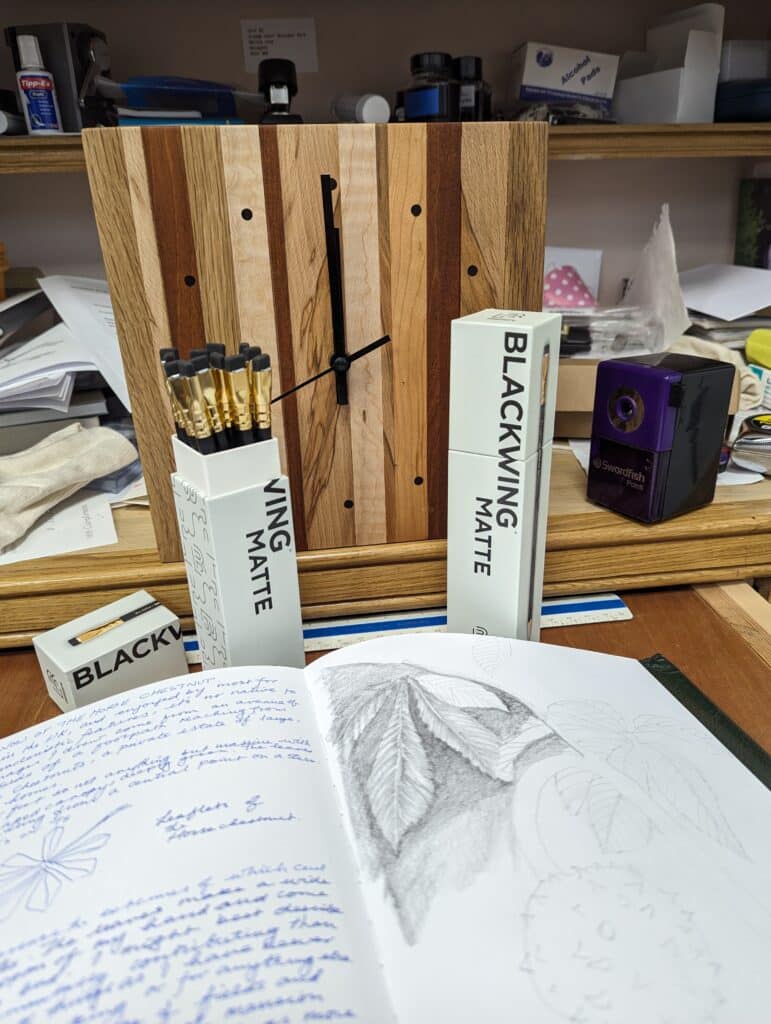
Most days I start with breakfast as no doubt others do. I have two main meals a day and rarely snack if ever. I’m something of a fruit and veg man and cook all things from scratch be that stir-fry fresh veg, frittata, soup or a curry. I make enough to serve for three or four meals. From there I am usually in a cafe for my first drink of the day and enjoy an Americano (UK for a coffee type-type). By seven I am working. My writing starts with long-hand in my journal and when I feel the need, every other day at least, I start a drawing. Though I have challenged myself with hands through the years, and the theme range is narrowed to woodworking, what I draw is rarely drawn. People hate drawing hands, apparently. According to them, others that draw and sketch, “Hands are so hard!” And it’s true. They demand pernickety (adjective Informal-British 1. placing too much emphasis on trivial or minor details; fussy) attention to detail. And working hands all the more.
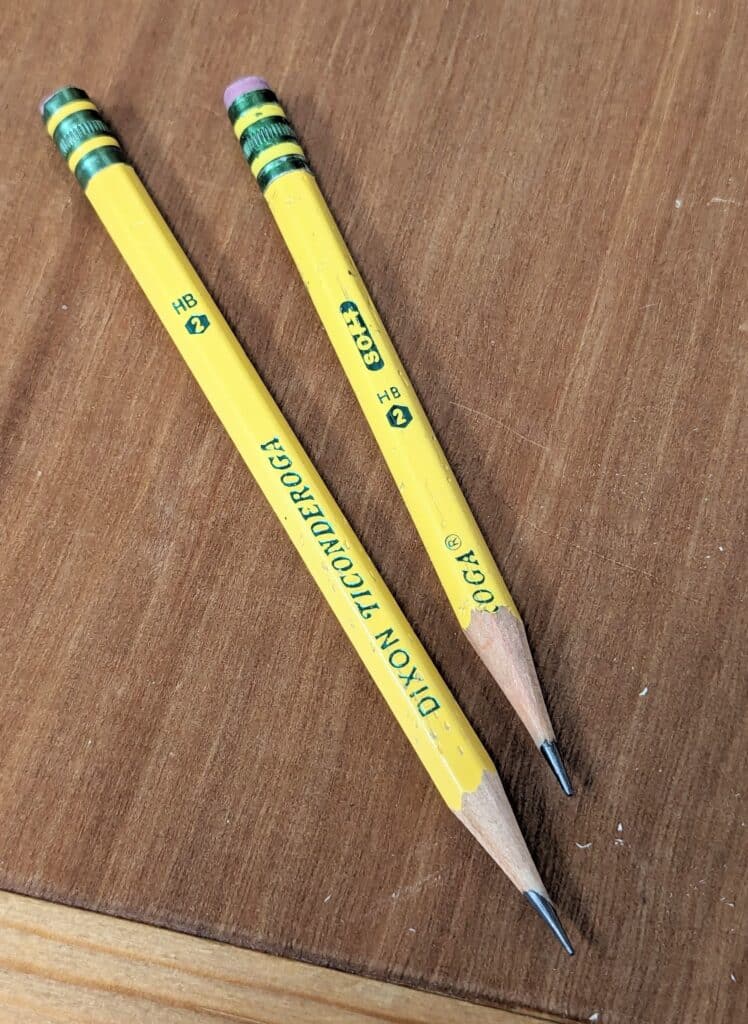
If you do fancy drawing then buy a drawing pad and a couple of half decent pencils. A “#2” (USA) equals an “HB” mid range, “H” stands for hard and we generally use “H” grades for more for technical drawing and the “B” range from “B1” to “B9” with the soft range of graphite for sketch type drawing, etc. These “B”s take take you through a good range from lighter with the lower numbers through darker to near black. In general I use a “#2” or “HB” for initial outlining and some light shading before changing to “B” grades.
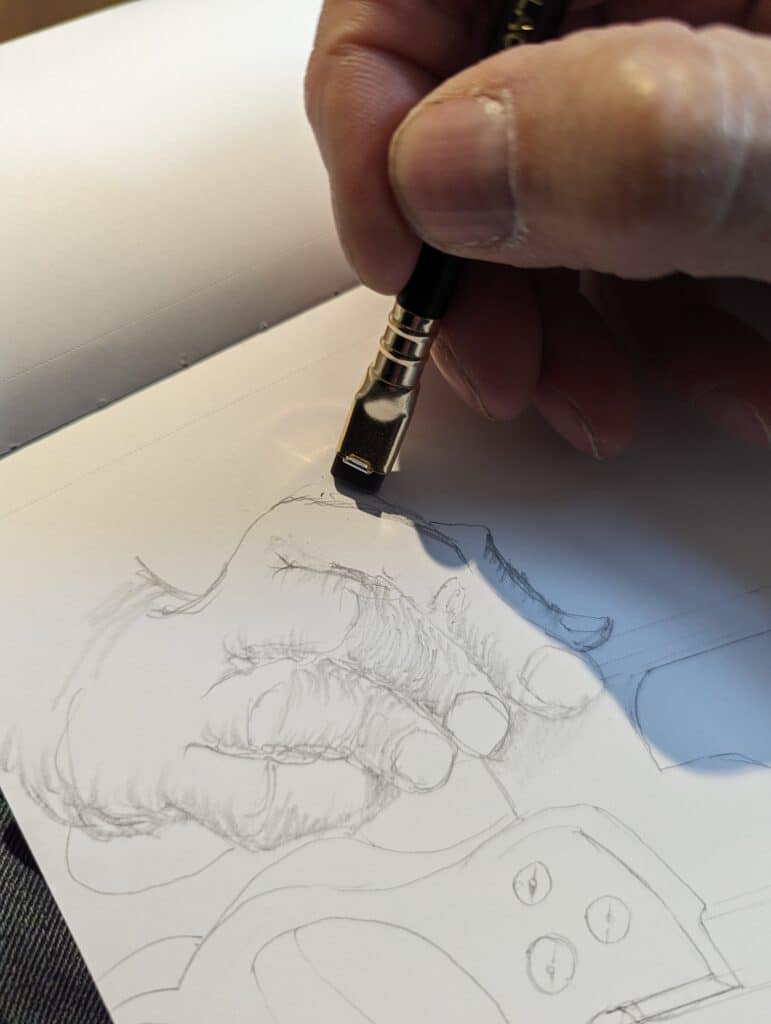
Whereas I like an eraser on the ends of my pencils it is more an American expectation than a European one and certainly not a British one. When I arrived to live and work in the USA in the 19880s you couldn’t buy a pencil without one. It made sense. I never really understood why European makers didn’t adopt the US versions by installing a very convenient eraser at the ends of their pencils. Unfortunately, when they do, they usually go for a cheap imitation plastic version that smudges the pencil marks unerasably but never erases it.
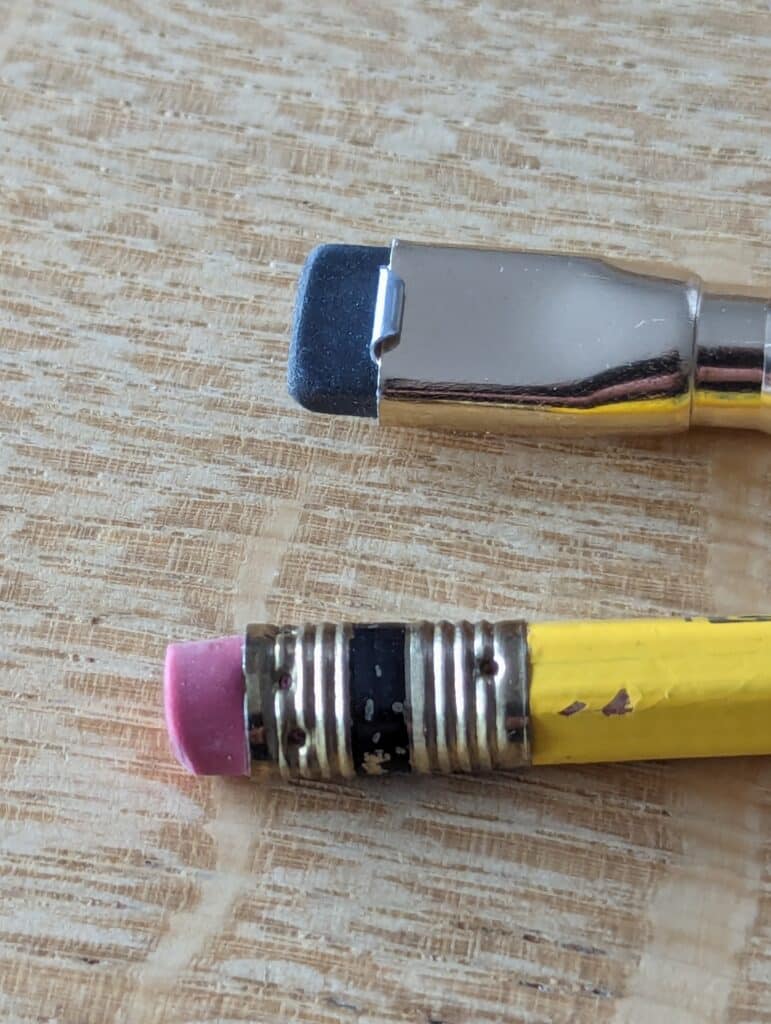
The wonderful thing about graphite pencils is the erasability throughout any work in progress. I find this especially important and especially in the early days of learning to draw be that technical drawing or sketch studies. I have heard of and hear of art teachers saying, “No rubbing out!” but this is the real advantage to erasable pencilling. Who is the one who can place lines on paper that perfectly represent the intent of the artist? A 2mm distance in correction is often transformative. Placing my opening lines on the page is preliminary; here is the point when I step back or extend the drawing with my arms to take a retrospective look at what I have pencilled. Alongside the fraudulent line I place a corrected one, half close my eyes and then remove the ill-placed one and look again. Perspective for hands and especially working hands holding tools and wood and such becomes all the more critical as ‘close-ups’. A fingernail at the wrong angle on the finger and a misaligned finger knuckle or a twist to the hand can mislead the eye even when the hand is distorted quite markedly from those hands that don’t work too much manually. Small corrections, pernickety ones, redirect the work in a most positive way. So, yes! Erase as necessary and make adjustments before you get in too deeply into the drawing. Do it!
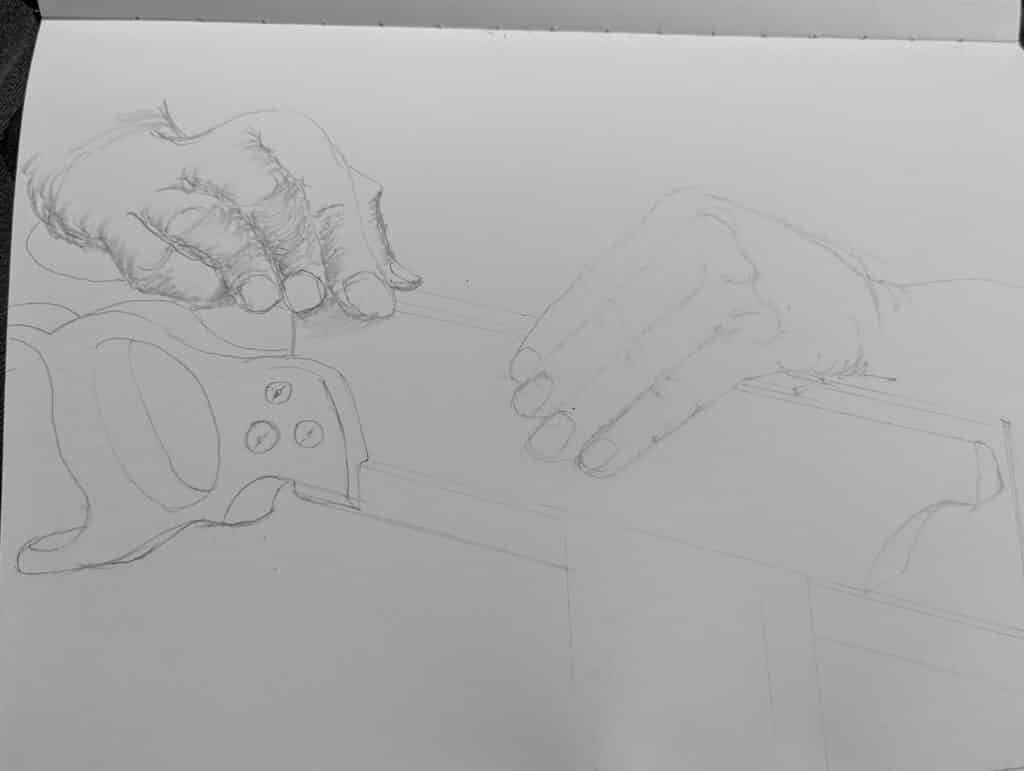
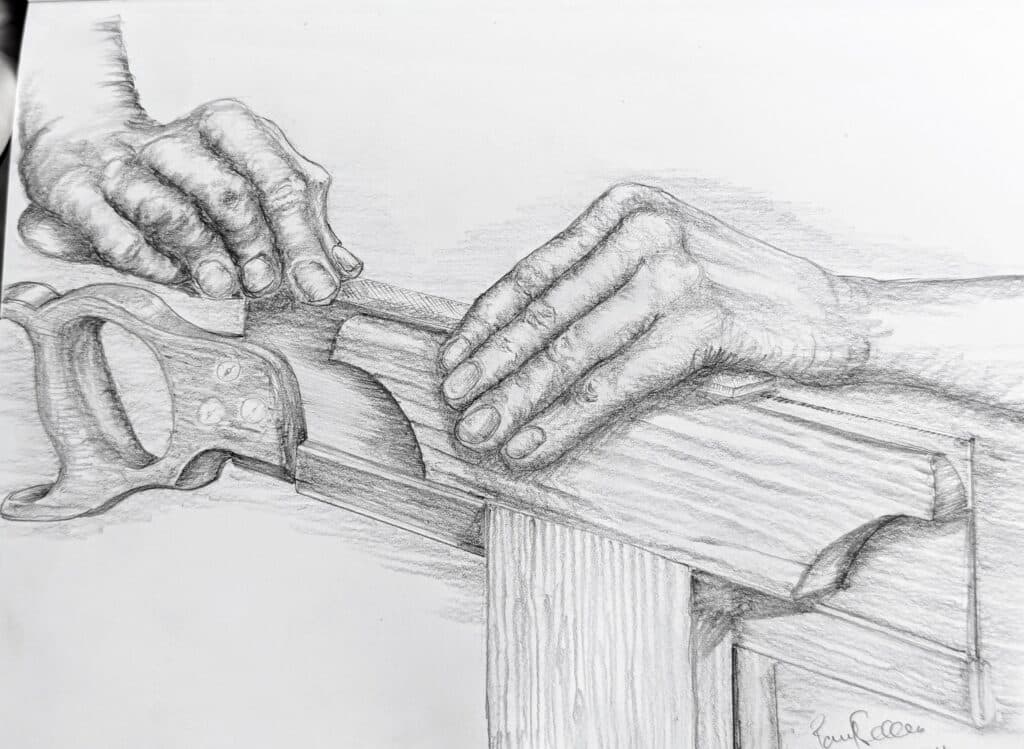
Blocking out as in above comes first in the training training to draw. Remember you are not drawing for the approval of others so don’t be saying to yourself, “I can’t draw!” and “I am no good at drawing.” If you haven’t been drawing a few times a week since you were ten years old and you are now 30 and didn’t draw since school how will you be good at it? And school is a good place to learn the three R’s of reading, ‘riting and ‘rithmetic but not the best at all for anything relating to the arts unless those teachers are true creatives. I have a close relative who currently teaches fibre crafts even though she never handled fibres beyon a few hours a week doing her course in college. She was recently told that she had to teach woodworking in the same college as part of her work. This person only ever handled wood when she was 13 years old in secondary school. Her knowledge of woodworking is right at zero. Who made this decision?
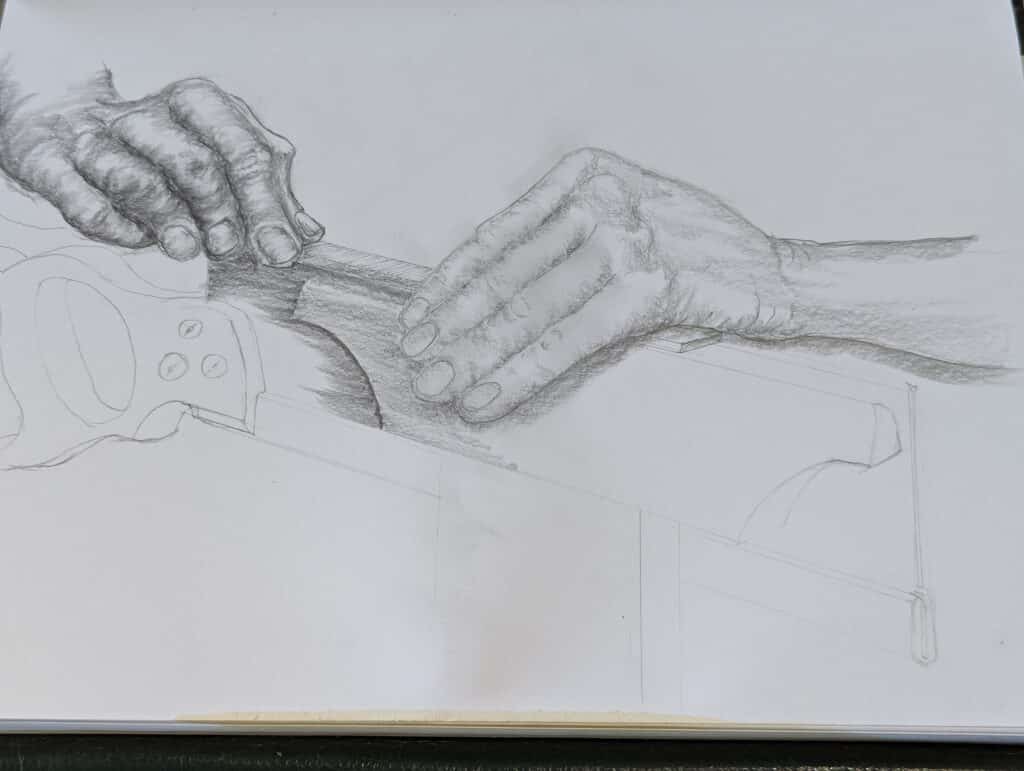
To begin with, you try to take in visually the picture in front of you by a quick exchange of glances where you separate out the blocks of solidity and open or blank space in what’s in front of you. Considering what you see engages with your pencil hand and you start to move your pencil to create roughly placed outlines according to what you see. `The two things that engage with one another through the brain are what you see with your eyes and then the pencil in your hand. You must think constructively to understand what you see and place the first few lines accordingly. I think it is important not to overthink this or spend too much time on it. Let the mental acuity come to the fore and don’t get rigidly locked onto anything.
Everything and anything is drawable. What stimulates us will draw our eye and inspire us to take up a pencil or record some image in our brain and then commit it to paper.
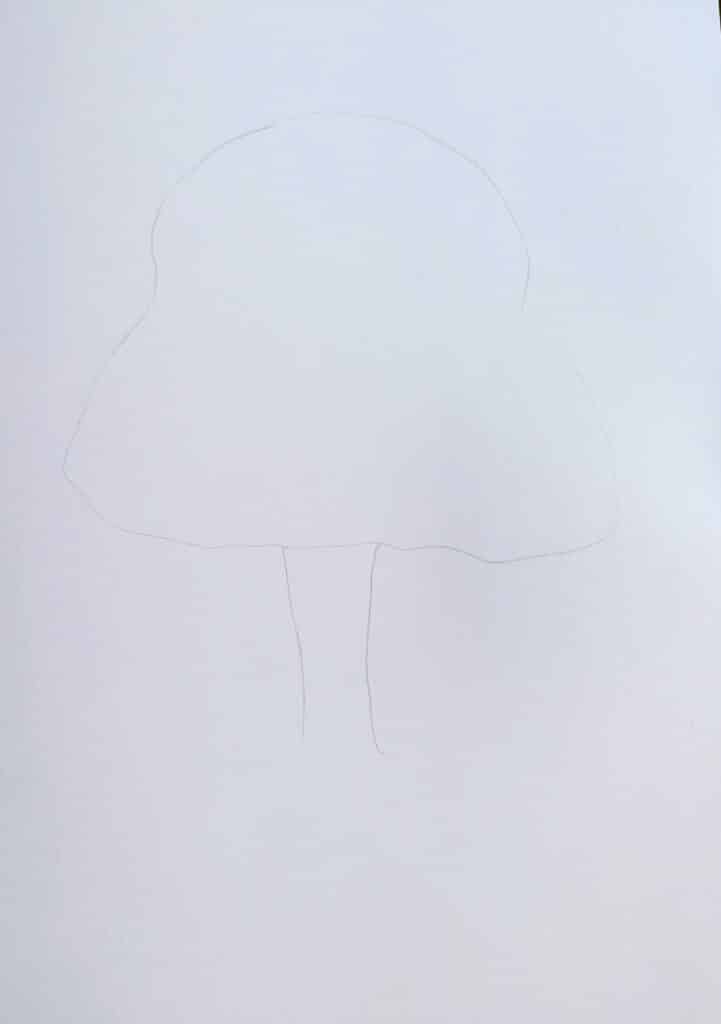
A tree might first take on the shape of an odd-shaped balloon with an ultra thick string for the stem. A continuous circling of the pencil for the dome and understory and two downward stokes for the trunk.
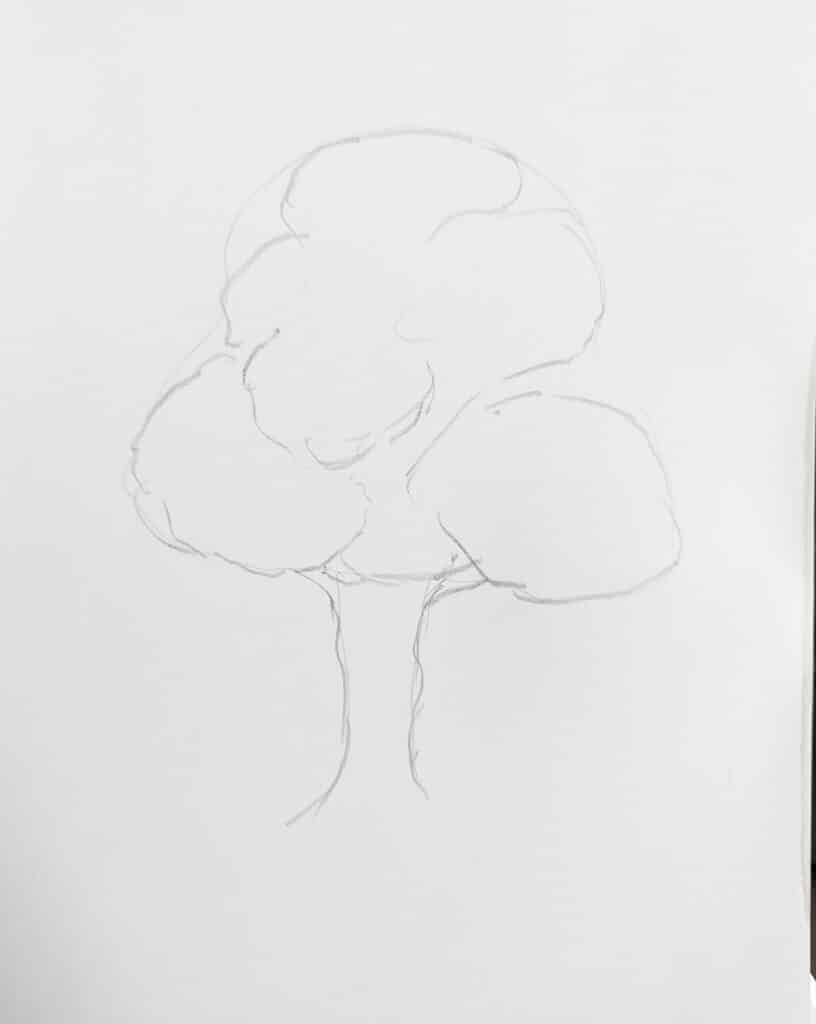
Once laid, you can go back in and define or refine things more accurately and clearly according to what you see. You can be working from real life in a field or wood or from a photograph. The next images show what I mean. This is under three minutes of drawing.
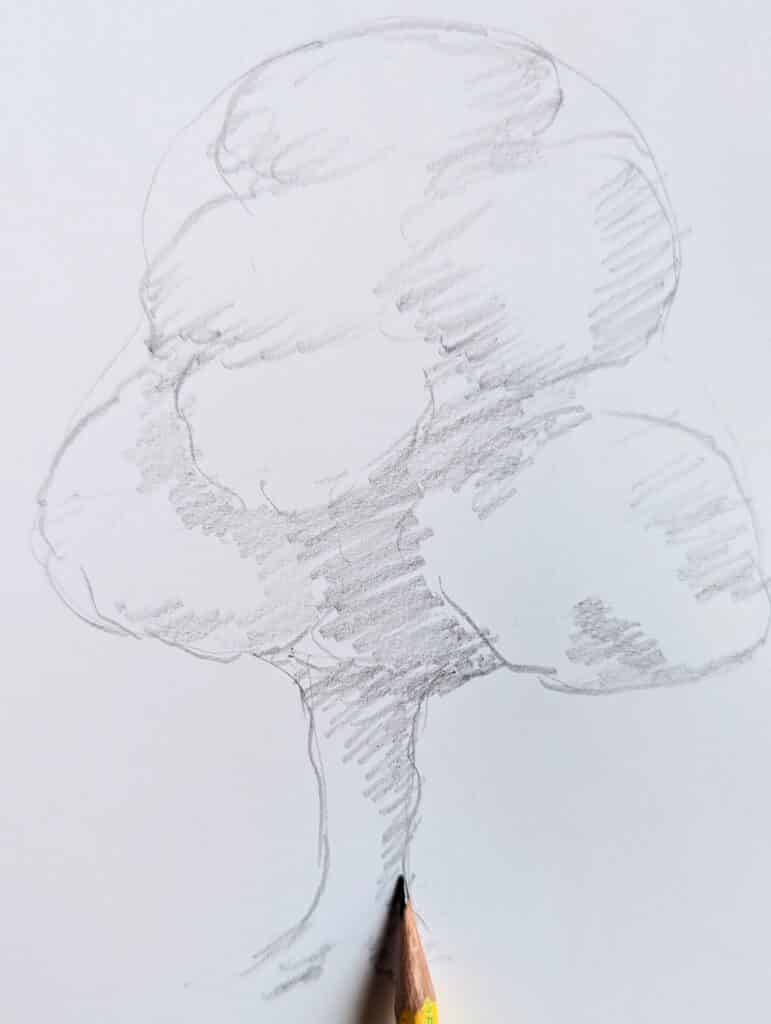
The initial outline gradually takes on additional detail,

Remember you have experiments you can adopt the outcome of for textures to bark and leaf sections.
When it comes to straight lines you might well have heard never use a ruler unless it’s a technical drawing. i would say use a ruler wherever and whenever you feel it best to even if it is a temporary line. I use them all the time for man-made elements of my drawing world. Buildings and furniture usually revolve around straight lines and comprise some sort of box. Remember the song, “Little boxes, Little boxes” by Malvina Reynolds, sung by her and by Pete Seeger? It was a kick against consumerism in the 1960s USA. Well, for us it’s about all the things being made are made with corners placed at 90º and forming boxes. Houses too are little more than boxes with angled roofs.
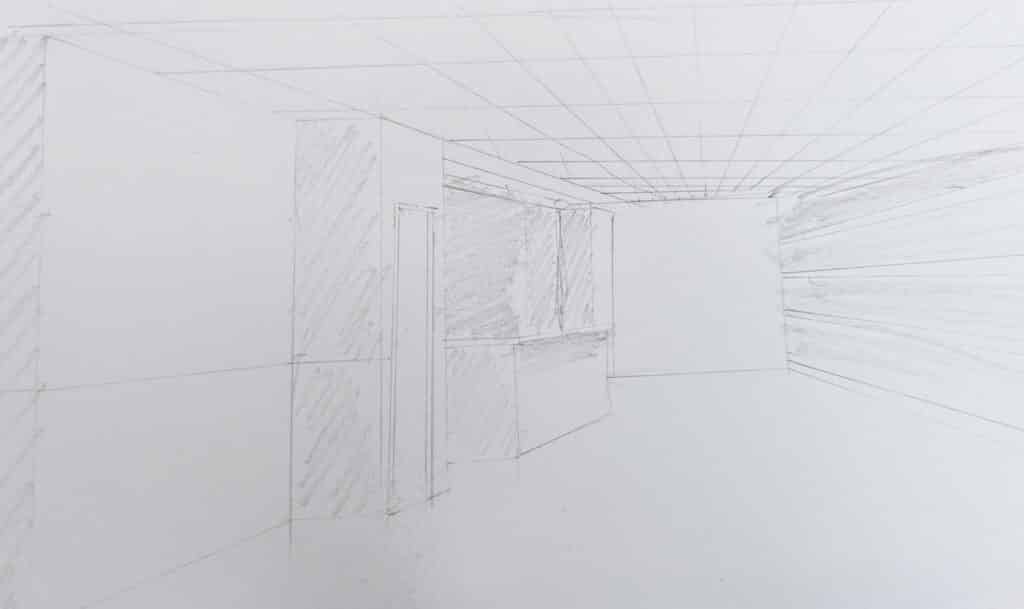
More symmetrical, angular, flat-faced sights like inside the interiors of buildings usually comprise what we might consider as large scale boxes looking angular and made up of many straight lines. These angled planes come to us as flats in squares and rectangles, triangles and appear as what we call solid geometric three-dimensional shapes where we see more than one flat face around us, perhaps as if we are looking at the inside of a box. Capturing these straight lines from our sitting or standing position can be difficult to put down on the page as we look up, left and right because our living and moving inside the ‘box’ only involve moving our head. from this ‘point of view’ we adjust to take in the lines and when we turn to our flat page we lose sight of whether the lines went up or down. This makes this type of drawing highly deceptive when we start out and that is because in the day-to-day of walking, working, shopping and so on we unconsciously pass through places and spaces that need none of our conscious processing––we rarely if ever give any of it much attention at all. But when we look at something to draw we start to actually ‘see‘ differently. Instead of passing through the scene we enter it from that point using only our eyes. When we begin to actually draw it is when we begin to really see the proportions, the heights and depths of what’s contained in our field of view; the distances, the angles and therein the lines that take our eyes from near to far and side to side begin forming and transforming the way we see things. And it is then that we begin to see tones and shades that give the depth we are looking for and this, these, begin our ability to understand contrast. Contrast, from the Latin contra “against” + stare “to stand,” to make firm. Literally to stand out.
To maximise contrast, depth of tone and so on, half close the eyes to exaggerate the lights and darks. You will often see artists do this. It’s a way of isolating the parts to work to.
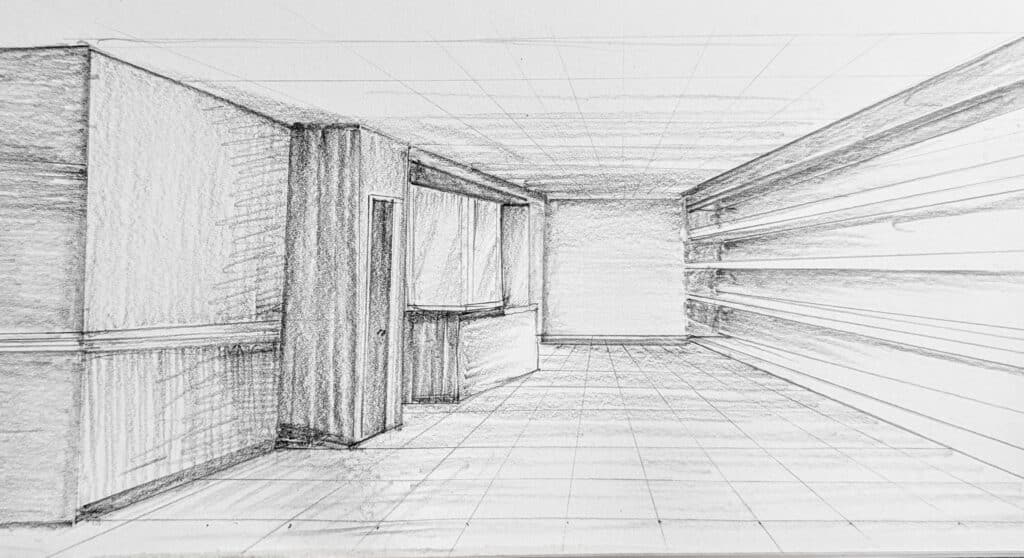
Go into a natural outdoor woodland setting left to its own and hardly a straight line exists anywhere you look. If you are indoors, look up at the ceiling wherever you are and you will see the straight lines converging somewhere in the furthest distance from you. In the image above you will see how those lines seem to narrow as they move furthest away from you––parallel ceiling lines and the vertical lines of walls, doorways and cabinets at corners, etc, where the walls and cabinets meet the ceiling or in the furthest distance, seem to get closer together even though, in reality, tape measure in hand, the distances of tiles on the ceiling or the passage between walls are all equally spaced.
Quite unconsciously, our minds simply (actually, more complicatedly than we can actually think) fill in the blanks. If we were to deny what we see we would not retain the visual perspective through our retina where our perceptions process all we see through photoreceptors that send the signals to the brain for interpretation. Unconsciously, we extrapolate what look like vertical parallel lines to create distance and depth of vision. This would not create a depiction of what we actually see at all yet the one that looks ‘out‘, as in ‘not quite right’, is the truer of the two. Well, this can be the same with the drawings we make of hands working even though there are no straight lines in hands anywhere. I’m hoping that this makes sense. It does to me.
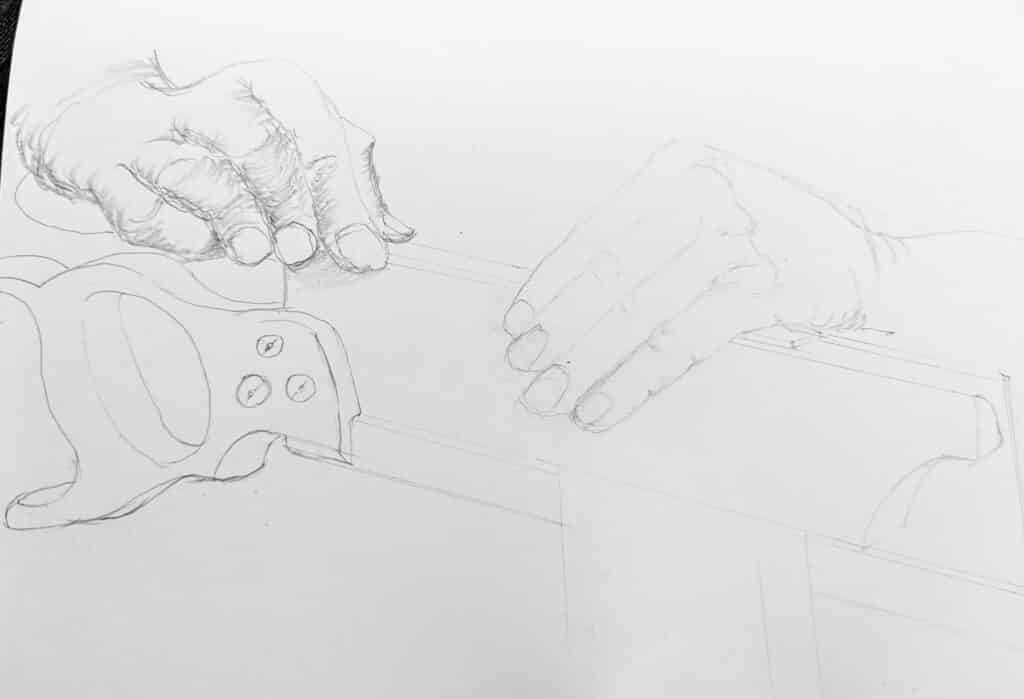
My first or opening pencil strokes position the components in several ways. For these hands jointing or topping a saw with a flat file to even the tooth tips I have the component of angles and these then relate to distances followed on by rough shapes all of which serve to establish positioning of the two hands, the tool being used and the work being done. There’s an etc in there too. There’s a lot going on, but what we are doing is breaking the scene down into bite sized pieces first. The best thing about pencil is you can erase and move the parts until they seem right to you. This comes as we go–– a work in progress.
I place these opening strokes with a certain degree of flexibility using the side of the pencil to make representative strokes on the page. I avoid using the actual point of the pencil as this impresses the paper and can be difficult to erase. Also, I want to stress that I use a very light application which makes any erasure quick and non-stressful on the paper. A light pass with the eraser then removes marks in a pass or two and doesn’t scuff the surface texture of paper.
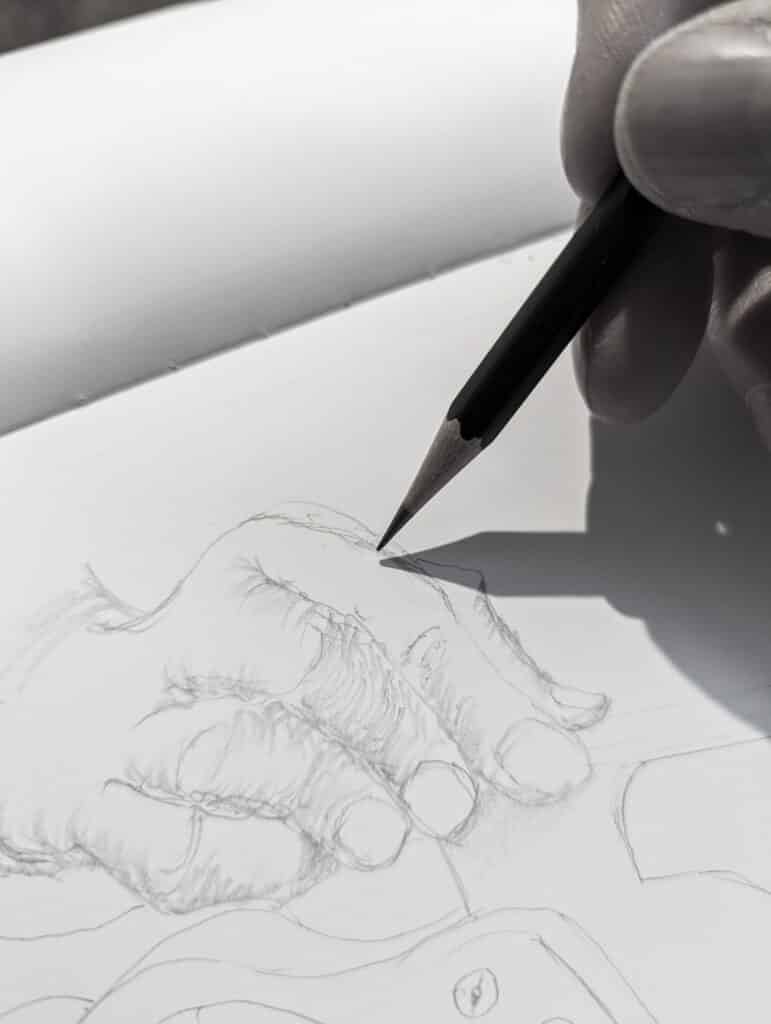
Once blocked out I look for shadows. Drawing is all about contrast and by adding some light shading I can add some pockets of contrast to guide me later. This early shading changes perspective and dimension to show under-shadow, finger bend and separation lines. This type of action is the same as making a note to myself that reminds me of something later. This becomes especially important where the drawing is from real life where two things can change in a minute, the person might move irrecoverably, or the light can change the shadowing. Isolating these things early on keep as notes for your later refining work.
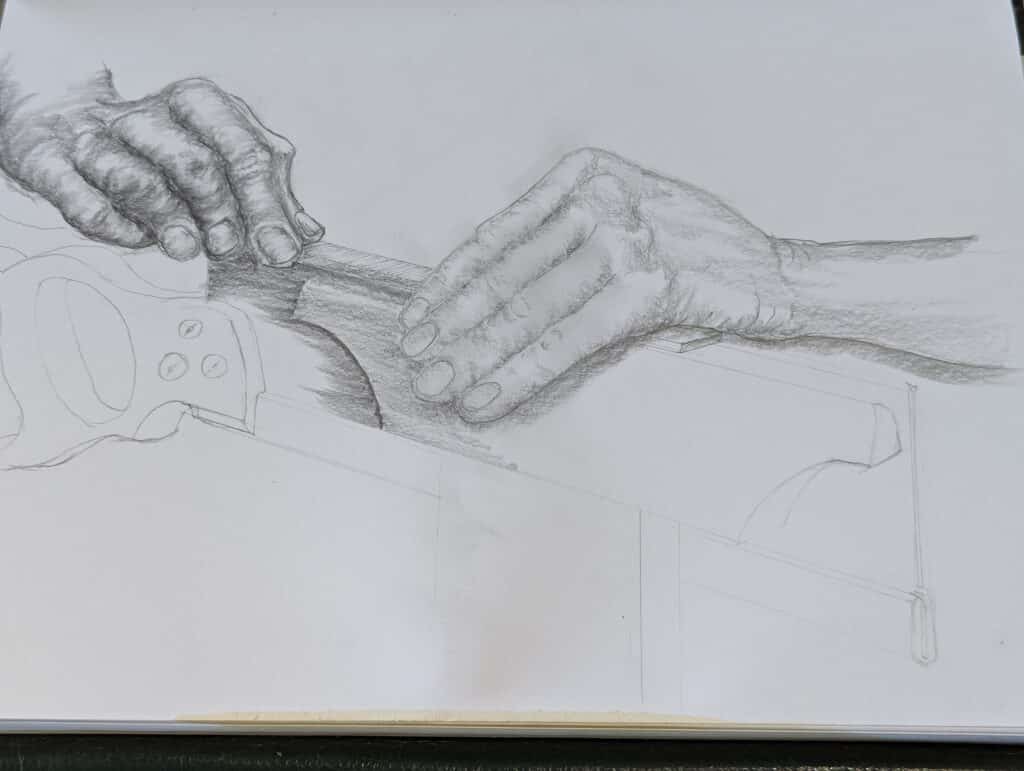
We are working by seeing colour because life is full colour but as we develop our image we are working pretty much in monochrome or perhaps more accurately, greyscale. Greyscale images are a type of black-and-white or grey monochrome composed exclusively of shades of grey. The contrast ranges from black at the weakest and white at the strongest. We push the boundaries of grey or graphite drawing from intense white, the paper we work on, or extreme grey, the nearest we can take graphite to black
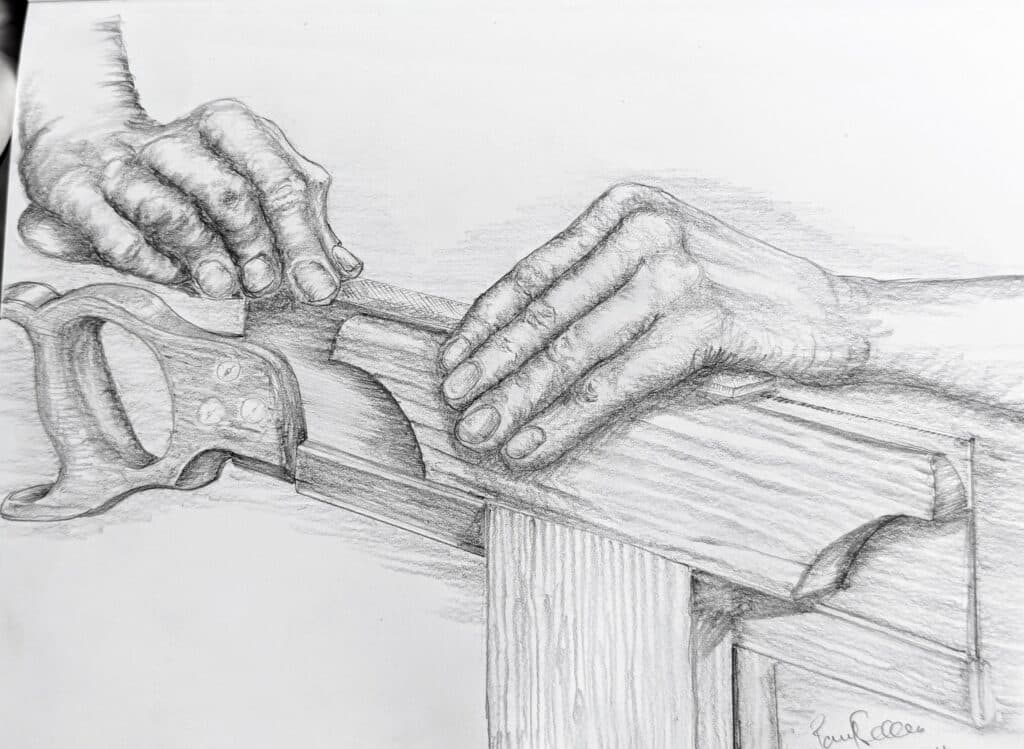
In the reality of our grey-scale monochrome drawing the dividing lines are not so much lines as we know them but shifts of tone from soft, slight and subtle or extreme tonal changes one up against the other and blended in gradients. It’s this then that takee the parts of our sketches and drawings from very direct contrast on through various levels of shading to achieve a lively outcome in our work––some pencil work moves more sharply and some moving from sharper to softer and all shades in between according to what I want to depict. These depths of darkness contrast the light ones. If you see an artist half close the eyes as they work they are creating tonal contrast in their eyes (and brain) to guide their pencil on the work.
In the composition above I relied on the shadows to give depth to the working hands and as these are representative of my own hands I am looking for a masculine look I get from my personally being a manual worker. Some times I am just plain pernickety and go for lots of detail, even too much sometimes, I admit, whereas a more minimal look might just convey more, it’s my choice as I move along. By the time I have reached this stage I usually do not go back into the drawing but I might.


Really lovely drawings Paul. Do you plan to any of your illustrations in your autobiography?
‘…include any of your illustrations…’ that should have read, apologies.
I am hoping that even totally unrelated ones will bring a fresh approach to the book so that will be my plan, yes.
“You talk too damn much and too damn much of it is about you.” ― Raymond Chandler, The Long Goodbye
This is absolutely wonderful !
Thank you so much for this wonderful work you share with us.
That’s a pretty good instruction on how to draw, “seeing” the tonal areas to try to reproduce.
But as with any skill, practice make progress.
Any bit of paper and a pen or pencil to doodle a tiny bit of a view is practice, doesn’t need to be like a DaVinci.
Just needs to be practiced and the eye hand coordination improves.
What a wonderful tutorial. I am currently designing some Japanese-style table leg bents that are evocative of a tree trunk spreading into a full tree. Thank you for all the drawing tips, Paul. You are a masterful teacher.
appreciate/admire ur ability to take the complex, whether it be as large as nature or as small as a dovetail, break the complex down into its individual components, then reconstruct it in clear concise terms. ur articles take me on pleasant thought-provoking journeys and leave me looking forward to the next journey. TY. B safe/B well
You couldn’t get Blackwing pencils for about 20 years from the late 90s until recently. They were the gold standard for the animation industry for ease of line and range of light and dark. While you could get pencils with similar graphite, the clamped eraser design is what made them special (to me anyways). I had heard that the erasers were to blame for them going out of production. Glad to see that you are enjoying them as I did back in my art school days.
I have started drawing a lot more since having a child a while back (and another addition, so I can start the process again!). I sit and draw her teddies. It’s great fun, and they move significantly less than the child herself. It surprised me just how “not terrible” I am, as I haven’t drawn in thirty years and was never great in the first place. I did a nice picture of a rabbit, which I glued to wood and carved out, similarly a butterfly. The options are endless in art and crafts, and I’m glad that it took a child to show me. I’m not trying hands though, hands are impossible!
Rico.
I agree with Robert. Your skillset is amazing. I really appreciate your style, and am delighted you’re getting to share this side of yourself with us. My favorite piece of my artwork is from my time in the School of Architecture-a highly detailed ram’s head (especially the horns.) My art professor knocked me down a grade because it was “too persnickety” (although she was too urbane to have known the word.)
Sir Sellers,
Have you ever used a Fibonacci gauge (golden ratio) in your drawings or woodworking? “The Fibonacci Gauges are tools to help Woodworkers design and layout their woodworking projects using the Golden ratio which will helps you design proportionally pleasing Woodworking projects.” It also is closely related to nature and therefore art;
https://www.compulsivecontents.com/detail-event/the-golden-ratio-and-fibonacci-sequence-in-art/
I’m not an artist in any way but I had to study art to get my degree. It is really interesting how nature my seem disorganized at times but there is an order to it.
When I look at woodworking, I can’t help but look for the Fibonacci sequence. I guess you would call it OCD.
Your drawings are as amazing as your workworking. Thanks for sharing how you created this piece.
Here’s one question I’d be surprised to hear you’ve gotten before, Paul😁: You have a pencil sharpener in your shop unlike any I have encountered in my life, of some 67 years. I have never seen, much less used, a crank-type sharpener into which you could insert a pencil, and then crank it sharp WITHOUT HAVING TO HOLD ON TO THE PENCIL! I’ve seen you use it several times, and it “appears” to be an ordinary schoolhouse sharpener. But that one feature, unless it’s an optical on-camera illusion of some sort, makes your sharpener a one-handed machine! An asset to any workbench or drafting table! Where EVER did you find such a gem?
These pencil sharpeners are pretty much ten-a-penny. I use the Swordfish ‘Pointi’ Desktop Manual Pencil Sharpener with its Helical Blade and Auto Stop Function [40235], black. It’s actually black and purple and costs around £7.50 so very very inexpensive without being cheap and cheaply made. Taken care of, they last for years. I just placed my order for two because after this the prices will go up. Oh, well, back to the drawing board.
Haha! There you go being an “influencer,” Paul! But don’t you have a hand-cranked sharpener in your shop, that you can crank without holding the pencil? I’ve had a number of these electric “grinders,” but can never get as good a point as I can with a hand-cranked version. Maybe I imagined it… it’s happened before. Thanks for the kind reply, sir. Happy you’re on the mend!
Ha! Too late, Paul! They’re AUD$25 here in Australia (nearly double 7 1/2 pounds) 🙁
No. I got two in yesterday for £14.40. I’m good for the remainder of my life if I indeed reach age 110 and I am the only user. But I lost out because currently they have gone DOWN to £7.05 including taxes, etc, free shipping on Prime too. Is this a sign that the Paul Sellers effect is now in decline???? I think Australia always seems high on prices than the rest of the world though, from what Aussies say. I know too that many countries hold their populations hostage when it comes to taxing imports and posted items. In 2021 I sent a $6 book from the US to a country in Europe and the duties charged were €25.
Paul, I enjoy your sketchings, but that is it for me. I have no desire to try and learn this art form. Having said that, don’t stop sketching! What works for one may not for another, but… through the sketchings I see how you may hold a saw, how you view a room, etc, and through your eyes I can see a lot of things I don’t, things which assist me in my many ways of living and learning. Through your teaching I hav made a great workbench, with additions and alterations to suit my style. Not everyone is the same, but sometimes we need another viewpoint to create what we are wanting to do. I would like to send you a photo of my workbench, in my favourite place (outside, under a LillyPilly tree) and see what you have inspired in an older person who has decided he is not yet ready to lay down. I hope your health is improving after your bike incident.
I understand that not everyone wants to draw, write or whatever else it is I do. I think it is important for me to do as I have with woodworking. offering an alternative that rapidly, not gradually, not without major effect, was being dismissed by a mass-majority of machine-only woodworkers who suggested perpetually that woodworking by hand was outdated and archaic when in reality it has real depth and positivity to it that most likely dismisses those who could or never would be able to use their methods of working wood. Drawing is often dismissed because of a lack of belief in themselves and yet all too often people fail to see how valuable an asset it is in crafts like woodworking. How often as a youth did the men split open a cigarette packet to then draw inside an idea they had. I want people to discover what others said of them that they couldn’t draw or whatever. Many do not realise that everyone can draw and 98% of doing anything is a made up mind. Put I do understand what you are saying and respect your point of view. And reference my bike happening, I am feeling much better and cn now work gently and a little more each day. Thank you.
My brother who is a creative person started as a woodworking teacher, then was told he had to teach “power mechanics” ( repairing cars ) and then at the end of his career “key boarding” (typing) . All the shop classes were shut down and the machines and tools sold for scrap. Not that it mattered because there weren’t many decent shop teachers anyway and today they are almost non existent in the public school system.
You’re absolutely on the mark with cheap pencils with erasers that smudge, some right out of the box and some after a month or two oxidize become hard and break apart.
I’ve come to buy a block eraser or rubber that works well except you only have so many corners to erase small areas.
Hi Paul. Lovely, insightful post.
We hope your recovery is progressing well. Have to ask, though, when you refer to having an American, do you mean coffee?
Best wishes,
KS
Salisbury, Maryland
Ah, should be more ‘Americano‘ in the UK. I’ve changed it. Thank you.
Good morning Paul,
You are a wonderful Artist…. who happens to also do wonderful woodworking!
I hope you are feeling better. God bless.
Paul, you inspire me and have done so in many ways. I have followed you for quite sometime now and you taught me the hand tool way. I have built like you most of the furniture in my house now. I have even started on a second round of furniture as I looked back and notice things I wanted to change or do better so that is my goal now. I will give most of the furniture away to families who need some things for there homes. I have a love for Cherry wood so all mine is in Cherry. Any way sorry I do go off sometimes. I wanted to talk about your drawing, I am not going to say I can not draw, but I will say I need to practice a LOT more. I am trying to understand my ideas and how to put them on paper. While I am turning 70 next year and still working full time, I would like to retire but as my jobs skills are in high demand and the money is great, they would like me to continue for another 5 years, not sure so I am taking it year by year. Some days I just want to go out to my shop and close the door and forget about everything else in life.
I am so glad you are on the mend Paul, I can not imagine what you have been through, but I truly hope and pray that you make a full recovery. I also hope and pray that in at least my life time I am able to see the book you write with all your drawings and sketches I would be willing to pay a good price for the book as well, just so I can view all your beautiful works. Thank you sir for all you do and have done for the craft.. All the best Paul and thank you..
Very nice artwork. It is obvious that you take much pleasure in progressing in your drawings. Have you got involved with painting in your art? I have tried a bit and found that coloured pencils are a great way to add colour to one’s art. The scene of yours with your hands working with the tenon saw and file really look good, thanks for sharing
Jim Monette
My interest started when I was young and I always enjoyed the instancy pencil sketching gave me. Additionally, I can sketch anywhere and at just about any time so on a train, in a cafe, chatting with friends and family and such. Drawing ties in with my woodworking too. I have and still use coloured pencils extensively especially when drawing for magazine articles in the USA and then my books too. I like watercolour and have yet to try oils or acrylics. Maybe one of these days.
I am pretty skilled in google sketchup, but grabbing a piece of paper and a pen or pencil and just sketch out my idea is a LOT faster. I now only resort to CAD when I need to do exact measurements and calculations.
And it was actually sketchup that demonstrated to me that my drawings could be a “haphazard” sketch. I created a very detailed 3D model for use in my blog, but it was way too polished. I wanted something that got the message through without being “perfect”. Sketchup has the ability to export 2D graphics in a variety of styles.
And I suddenly understood how I could draw nice sketches without being skilled in drawing at all.
Thank you for posting this, Paul – demonstrating how the tree emerged on the paper, and especially the detail about shading, was enlightening.
One time p, some years ago, I happened to attend an art show. It is always so inspiring to see what others are doing. I walked into a room and began looking at one of the artist’s work, she had about ten or fifteen pieces depicting people and surroundings in various ways and poses; she is good at her craft! I walked up to and complemented her about her use of “ shadowing “ in the works. She looked at me with amazement and said “ no one has ever told me they really liked my use of shadowing “. I was surprised by her comment but I guess shadowing in artwork has always amazed me, to me, that is what ties everything together. I think the artist felt complimented by my remark, it made me fell good.
Paul,
Awesome job on the sketch of you working on a card scraper. I can almost feel the extra forces in your right hand. I guess it the shading and the presentation of your fingers. Perfect!
Thank you Paul. It has taken me a while to even dream of drawing. I still think at times in high school being given a block of wood and told to carve something. I froze with no idea as to what to do. Received an “F” on that one. Even approaching 70 I have to stop and be reminded “self crucial is the worst”.
I then remember my kind mentor Mr Amos with hands like a bear who would say after I cut a board a bit short, “That’s ok son, we have plenty and can use that one in a minute. We will never run out of lumber.”
I still appreciate his kindness now these almost 50 years later.
You remind me a lot of that fine gentleman.
You’re right about the importance of drawing in hand woodworking, and it applies to other activities, too. Drawing was seen as an essential skill by the late Christopher Clarkson, my bookbinding conservation tutor at West Dean College, Chichester. He insisted that we take life-drawing classes, before moving on to objects, including book-structures. He himself was a superb draughtsman, and his drawings informed his work and publications. He knew that a drawing could convey more information than a photograph. This and another skill – technical drawing, which I learnt at school – have helped my amateur woodworking. I used to, and still do, have difficulty visualing joints in wood; drawing them in three views (plan, and side and end elevations) helps a lot.
I started using the Dixon Ticonderoga #2 in grade school, and have used one every day since (I’m 57 now). I think it’s the best all round pencil you can get at a reasonable price here in the US.
Thank you for this. It is so very helpful to hear of the process and the approach to drawing. More so, it was helpful to read of your experience of the process and experience it along with you through your writing. I find it difficult to see the negative space, which is helpful when looking at some compositions. It isn’t something I do or experience unless I deliberately remember to look. Similarly, I’ve yet to make much progress in shading and I think this is because it is hard for me to see value. My eyes want to see the hue and I don’t see the greyscale / value of the scene unless I look hard and deliberately. I am sure you will say it is practice, and I am sure you are right.